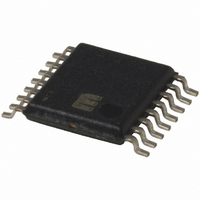MIC2584-JBTS Micrel Inc, MIC2584-JBTS Datasheet - Page 22

MIC2584-JBTS
Manufacturer Part Number
MIC2584-JBTS
Description
IC CTRLR HOT SWAP DUAL 16-TSSOP
Manufacturer
Micrel Inc
Type
Hot-Swap Controllerr
Datasheet
1.MIC2584-JYTS.pdf
(28 pages)
Specifications of MIC2584-JBTS
Applications
General Purpose
Internal Switch(s)
No
Voltage - Supply
1 V ~ 13.2 V
Operating Temperature
-40°C ~ 85°C
Mounting Type
Surface Mount
Package / Case
16-TSSOP
Linear Misc Type
Positive Low Voltage
Family Name
MIC2584
Package Type
TSSOP
Operating Supply Voltage (min)
1V
Operating Supply Voltage (max)
13.2V
Operating Temperature (min)
-40C
Operating Temperature (max)
85C
Operating Temperature Classification
Industrial
Product Depth (mm)
4.4mm
Product Height (mm)
0.9mm
Product Length (mm)
5mm
Mounting
Surface Mount
Pin Count
16
Lead Free Status / RoHS Status
Contains lead / RoHS non-compliant
Available stocks
Company
Part Number
Manufacturer
Quantity
Price
Company:
Part Number:
MIC2584-JBTS
Manufacturer:
MIC
Quantity:
23
Company:
Part Number:
MIC2584-JBTS
Manufacturer:
MICREL
Quantity:
240
Part Number:
MIC2584-JBTS
Manufacturer:
MICREL/麦瑞
Quantity:
20 000
MIC2584/2585
Higher UVLO Setting
Once a PCB is inserted into a backplane (power supply), the
internal UVLO circuit of the MIC2584/85 holds the GATE
output charge pump off until VCC1 exceeds 2.165V and
VCC2 exceeds 0.8V. If VCC1 falls below 1.935V or VCC2
falls below 0.77V, the UVLO circuit pulls the GATE output to
ground and clears the overvoltage and/or current limit faults.
For a higher UVLO threshold, the circuit in Figure 10 can be
used to delay the output MOSFET from switching on until the
desired input voltage is achieved. The circuit allows the
charge pumps to remain off until V
threshold. Both GATE drive outputs will be shut down when
V
rising UVLO threshold is set at approximately 9.0V and the
falling UVLO threshold is established as 8.9V. The circuit
consists of an external resistor divider at the ON pin that
keeps both GATE output charge pumps off until the voltage
at the ON pin exceeds its threshold (V
up timer elapses.
Hot Swap Power Control for DSPs
In designing power supplies for dual supply logic devices,
such as a DSP, consideration should be given to the system
timing requirements of the core and I/O voltages for power-
up and power-down operations. When power is provided to
the core and I/O circuit blocks in an unpredictable manner,
the effects can be detrimental to the life cycle of the DSP or
logic device by allowing unexpected current to flow in the core
and I/O isolation structures. Additionally, bus contention is
one of the critical system-level issues supporting the need for
power supply sequencing. Since the core supplies logic
control for the bus, powering up the I/O before the core may
result in both the DSP and an attached peripheral device
MIC2584/2585
1
IN1
R2
R1
falls below
1.235V
1
12V
V
provided that VCC2 has exceeded its
Undervoltage Lockout Threshold (rising) = 9.0V
Undervoltage Lockout Threshold (falling) = 8.9V
Undervoltage (Output) = 11.4V
Channel 2 and additional pins omitted for clarity.
IN1
R2
R1
24.3k
154k
1%
1%
R1
R2
1.21V
(18V)
D1
. In the example circuit , the
ON
) and after the start-
C1
1 F
6
Figure 10. Higher UVLO Setting
ON
IN1
VCC1
3
16
1
R
0.010
SENSE1
exceeds
5%
SENSE1
MIC2584
GND
2
4
15
9
22
GATE1
being simultaneously configured as outputs. In this case, the
output drivers of each device contend for control over sending
data along the bus which may cause excessive current to flow
in one of the paths (I
Figure 11. Upon powering down the system, the core voltage
supply should turn off after the I/O as the bus control signal(s)
may enter an indeterminate state if the core is powered down
first. Thus, for power sequencing of a dual supply voltage
DSP implementing the MIC2585 (if V
similar to Figure 8 is recommended with the core voltage
supplied through Channel 1 and the I/O voltage supplied
through Channel 2. For systems with V
MIC2585-2 option with the I/O voltage through Channel 1 and
core through Channel 2 is used to implement the first on-last
off application.
Sense Resistor Selection
The MIC2584 and MIC2585 use a low-value sense resistor to
measure the current flowing through the MOSFET switch
(and therefore the load). This sense resistor is nominally set
at 50mV/I
ances for both the sense resistor (allow 3% over time and
temperature for a resistor with 1% initial tolerance) and still
supply the maximum required steady-state load current, a
slightly more detailed calculation must be used.
The current limit threshold voltage (i.e., the “trip point”) for the
MIC2584/85 may be as low as 42.5mV, which would equate
to a sense resistor value of 42.5mV/I
numbers through for the case where the value of the sense
resistor is 3% high yields:
Once the value of R
it is good practice to check the maximum I
the circuit may let through in the case of tolerance build-up in
FB1
R
SENSE(MAX)
14
12
IRF7822
(SO-8)
Q1
LOAD(CONT)
R3
10
C2
0.01 F
1.03 I
SENSE
R4
133k
1%
R5
16.2k
1%
1
. To accommodate worst-case toler-
or I
42.5mV
LOAD(CONT)
2
) shown in the bidirectional port of
has been chosen in this manner,
C
1000 F
LOAD1
12V@4A
LOAD(CONT)
V
OUT1
CORE
I
LOAD(CONT)
41.3mV
LOAD(CONT)
CORE
V
. Carrying the
I/O
March 2005
< V
), a circuit
I/O
(11)
Micrel
which
, the











